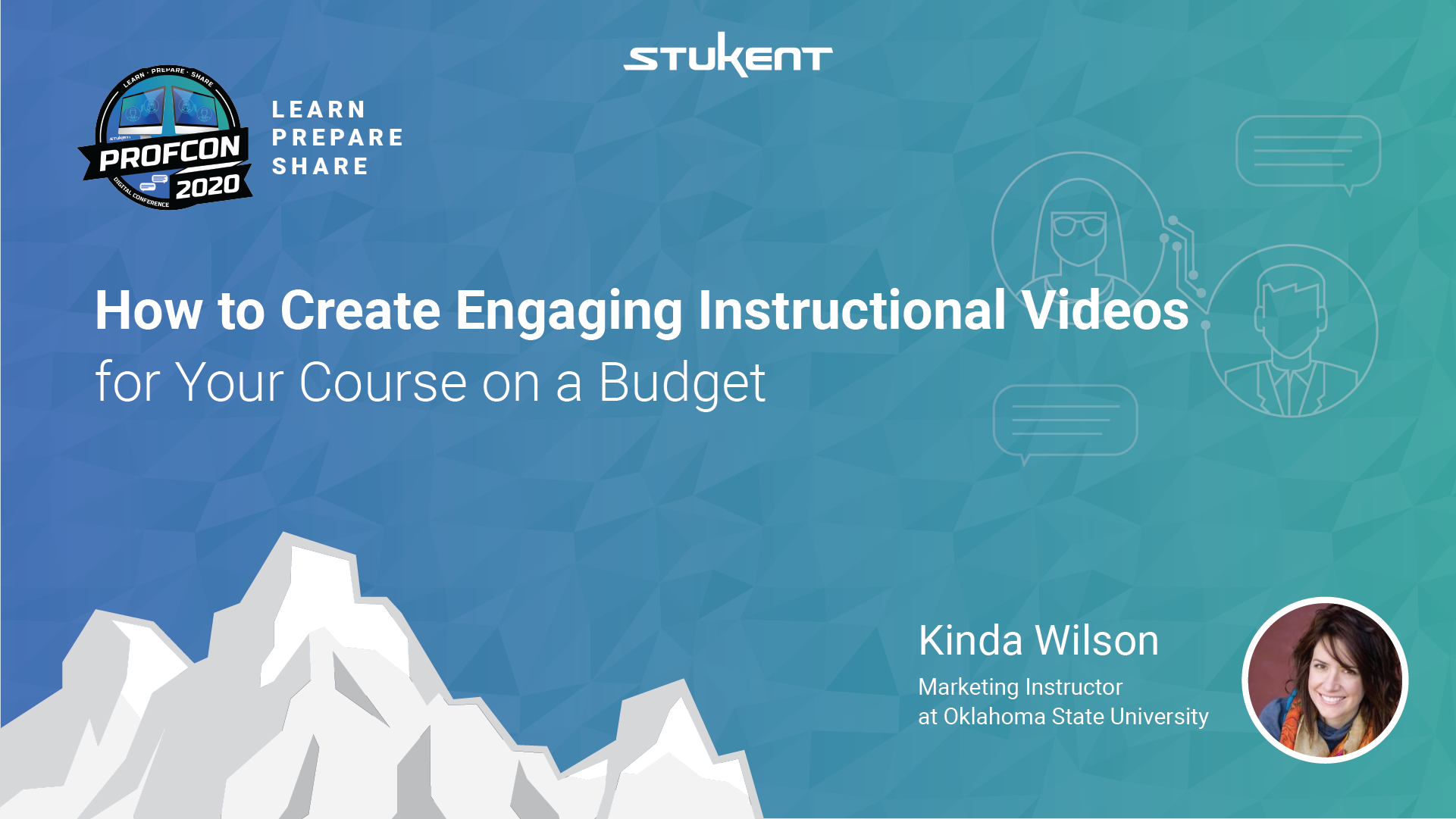How do we draw students in and get them to want to watch a video? How do we create a video that keeps their attention and helps them learn the material? How do we create a video that encourages them to interact and enjoy the learning process? I’m going to discuss videos and video editing techniques that will help you create engagement — no matter what your current skill level. Here are some simple tips and resources you can use to produce engaging instructional videos.

Resources for Editing Videos
One thing to be aware of is that the video camera takes away 50 percent of the energy, so if the energy you have in the classroom doesn’t translate to quite as much energy when you’re reviewing a video, please know it’s okay to be a little more animated than you would be normally. It’s okay to add elements to make a video seem more energetic or engaging. I recommend editing your film to short clips that are five to ten minutes in length. Some of my videos are longer, but I like to give the students a chunk of information at a time.
Here are a few of the video editing software options I’m familiar with:
- Canvas Studio has editing features that are really pretty good. Both you and your students can upload, create, edit, manage, share, and discuss the lesson. You can even create your videos with Studio’s capture and editing tools.
- YouTube Studio allows you to make changes to videos on your YouTube Channel. You can alter the title, description, and settings. Editing functions include trimming videos, adding end screens, adding audio, and blurring sections of a video. You can also add subtitles.
- iMovie is an option many of your students are probably already quite familiar with. The platform is accessible via an iMac or any iOS device, and it offers rather robust editing options. Special effects, soundtracks, high-fidelity filters, and other options are all available with iMovie.
- Adobe Spark gives you the ability to create and edit short videos. Adobe Premiere and Final Cut Pro come with a little higher learning curve, but give you more options. Note that if your university has a licensing agreement with Adobe you may have free access to the software.
- LinkedIn Learning now owns the Lynda training films. You’ll find a treasure trove of learning resources with thousands of hours of video training for anything software-related, all chunked up into brief tutorials. I used Lynda resources when I didn’t know anything about video editing, but by the time I was finished, it seemed like I had a college degree in the topic. LinkedIn Learning does come with a price tag, but it’s totally worth it.
Adding Creative Elements to Videos
Something you’re probably already doing is adding creative elements to bring your concepts to life. Online students can’t ask a live question like they do in class, so the more you can bring a concept to life, the more engagement you’ll get.

Visual or audio elements help demonstrate and illustrate the core concepts to help students learn. Creative add-ons help build energy to pull viewers in, so here are a few brainstorming tips that will help you do that:
- Begin with a topic outline. I like to sketch the topics I’m delivering in the lecture. One thing about filming short videos is it kind of forces you to pare everything down to the core content. Once you create a topic outline, pull out the ones that are crucial to the class and note the ones students might have trouble with.
- Think of visual examples you could include. What stories do you think of, what are the words or visual elements that come to mind? In my design class, for example, when we talk about Pantone, I tell a story about my mom calling it “Pantene” the shampoo instead of “Pantone.” That may be a little silly, but it brings energy to the video and helps it stick in their minds.
- What questions might students ask? This is a way to bring an element of a real-life lecture into your filming. I like to picture who I’m talking to. I know my most eager students are asking in-depth questions, but some students aren’t paying attention too well, so I might have to repeat things or explain a few things. Then there’s the mischievous student. I like to add places in the film where it’s as if I’m talking to those students individually. You can pretend like the video camera is any of those students. Speak directly to them, answer those tough questions, think about visual elements you can add to illustrate your points
- Get creative when you’re filming from home. Look around the house to see what props you can use to visually demonstrate what you’re talking about. What good or bad examples can you use? How can you show what not to do?
- Use animated graphs or typography. If I’m talking about a statistic, I like to use animated graphs. They add energy and motion that can help keep students watching. More than that, it makes it seem as if the pace of your video is faster when you add a visual element with motion. I even add some animated typography (like a flying word) now and then.
- Use website examples by taking screen captures. Think about which websites and company examples can reinforce your points. Screen captures of website examples are a way to show a visual pretty easily. You don’t have to go off and find that information, since it’s easy to access via your computer.
- Add audio elements. Consider the type of music you could add in. What sound effects could you use to augment what you’re talking about? You might even find television clips related to your topic. When you do that, though, remember that they’re covered by Fair Use. Always be sure to link back to the source. Think about how to add the unexpected to keep students watching.
Sources for Free and Cheap Elements
Adobe Stock photos are excellent, and your school may provide access to them. They’re all high-resolution and royalty-free.
Unsplash is a terrific source of free images, though they tend to focus on nature or people and don’t have a lot of good business-related photos.
Canva has both free images and a really good library of stock images for 99 cents each. It’s also a platform you can use to create graphics.
YouTube Audio Library offers a good selection of royalty-free production music and sound effects to use in your videos. They are free to download and use in your videos, but some do have attribution requirements. New content is added monthly. Look for the Audio library link in the left sidebar on your YouTube Channel.
Fiverr.com is a site where you can hire independent contract work in all sorts of areas, video and audio included, for reasonable prices. Look for people who have good ratings, and be sure to discuss your project and your vision with them before assigning the work. I bought a ukulele intro song to use on one of my videos for six dollars on Fiverr. You can get ideas by browsing the different offers there. Find something you like, then figure out how you can use it in your lessons.
Screencast-O-Matic can be a big help for everything from screen captures to video editing, and it launches right from your browser. I use this one quite a bit when I’m doing social media training. You can also get stock images there.
Envato Elements is one that I am geeking out about. It has been a lifesaver for me for finding creative elements. I used to use the Envato marketplace and pay twenty to eighty dollars for a custom video clip or an animated template. With Envato Elements, they’ve taken millions of those items and made them all available on one site. If you’re using Stukent’s “Modern Marketing Principles & Video Case Studies,” curriculum, much of the video cases and stock footage in there is from Envato. My whole team uses it now, and it’s well worth the money for the content you get. It is an amazing resource.
Sites for free animated stories include Powtoon, Raw Shorts, and Vyond (which used to be known as Go Animate). These are a little tricky and cumbersome, and they’re templates, but you can get some good content there, either for free or at a low cost. Note that Powtoon offers a student plan.
Practical Application Tips
Another way that you can add in energy is by bringing people into the film to reinforce the ideas. Clips like that break things up a bit. You can even do interviews in the field. This can be really helpful if you’re just beginning with videos and you’re uncomfortable with the process. Bring someone in to the shot, and have a conversation with them.
Informal shots aren’t filmed in a studio, your production team probably isn’t traveling with you to a conference, and they’re certainly not there at the coffee shop when you run into Seth Godin and want to get some footage of him talking about branding. So, let me give you a couple of practical application tips you can use to make the shot look a million times better. All you need to do is keep a couple of simple things in mind.
You can use your phone for filming. Look for an area where it’s quiet and well lit, but you don’t want a backlight, and you don’t want a crazy background. You may get interrupted by a kid running through screaming or another type of noise, so you’re not going to get studio-quality work. Always use horizontal orientation (widescreen). Here’s a little trick to boost the quality of your filming: bookend your clips with the studio lecture. They can help change the pace. I’ll say something like “Now let me show you an example with this live shot,” then insert a bookend clip or clips from the field before going back to the lecture video. So, instead of students thinking “That’s a bad quality clip,” it fits in naturally, and they understand it’s not meant to be expertly filmed.

Video Technology for Filming Lectures
You don’t have to spend a fortune on technology to get acceptable results. Back in the day, cameras and other video equipment were expensive, but now all you need is a $20 microphone and a smartphone. You can get a tripod for not too much money, and you can carry an old phone as an extra for two-camera shots or to use just for audio. Ring lights are great for home, and you can set up your own studio for almost nothing.

Finally, create points where students are interacting with the video. Provide opportunities within the production, for instance, where you ask a question to the class. Canvas has an option that allows you to turn on commenting. Ask simple questions, not complex discussion board questions.
I’ll say something like, “What does this logo remind you of? Say the first thing that comes to your mind and put it in the comments. That brings this element of, “Oh, something was asked of me, and I need to respond.” It helps keep the class on their toes. Then I come and respond to those comments. Attach engagement points.
You might even offer bonuses or badges for people who add to the discussion. It helps you see who’s staying on top of the work and gives you the chance to encourage engagement from students. If you want them to participate, you have to ask and give them a way to engage. I also use student-created content in my video lectures. I like to pull some of those and do a weekly shoutout video. It reinforces the ones who are working hard, and it also gives other students ideas about content they can create.
Adapted from Professor Kinda Wilson’s presentation at Stukent’s ProfCon 2020

Speaker Bio: Kinda Wilson is a marketing instructor at the Spears School of Business at Oklahoma State University. Her marketing and business experience ranges from working with corporations and nonprofits to founding three start-up companies, one of which was named a Top Ten Innovative Startup Company in Oklahoma. Kinda is passionate about bringing business and marketing concepts to life for her students and was awarded the 2017 Excellence in Teaching/Training Award by the United States Distance Learning Association (USDLA). Kinda is also coauthor of the Stukent textbook “Modern Marketing Principles” and TEDx speaker.






